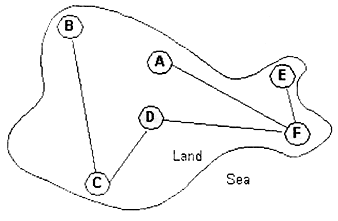| (a) | There have been attempts to provide a unified
approach to cognitive science. However, at this moment, there is no generally accepted
concept of what cognitive science is. Briefly describe one problem that may explain this
difficulty.
|
[2] |
| (b) | Define a predicate expression to define a
triangle using the following predicates : line (A, M, N) : A is a straight line on a 2 dimensional plane, where M and N are points represented as (x,y) co-ordinates on the plane. angle (A, B, D) : Lines A and B have an angle of D degrees. triangle (A, B, C) : Lines A, B and C form a triangle.
|
[4] |
| (c) | The following diagram shows a country where
the major cities are linked by a rail system. You know the distance between the cities. To
get from one city to another, we can proceed without making use of any information about
the geography or the rail system at all, or we can make use of available information
intelligently using heuristics. (i) Briefly describe how you would get from one point to another using the first approach, i.e. a blind approach. (ii) Using only distance as a basis for designing a heuristic approach, explain how you would travel from one city to another. (iii) When would problem solvers employ heuristics?
|
[1] [1] [2] |
| (d) | Template matching is one common technique for
recognizing patterns. While it has its strengths, template matching has some drawbacks to
make it suitable only for some limited applications. Briefly describe two problems of
template matching.
|
[4] |
| (e) | As natural language is complex, it is broken
down into different levels so that it can be managed easily. Briefly describe any six
levels.
|
[6] |
